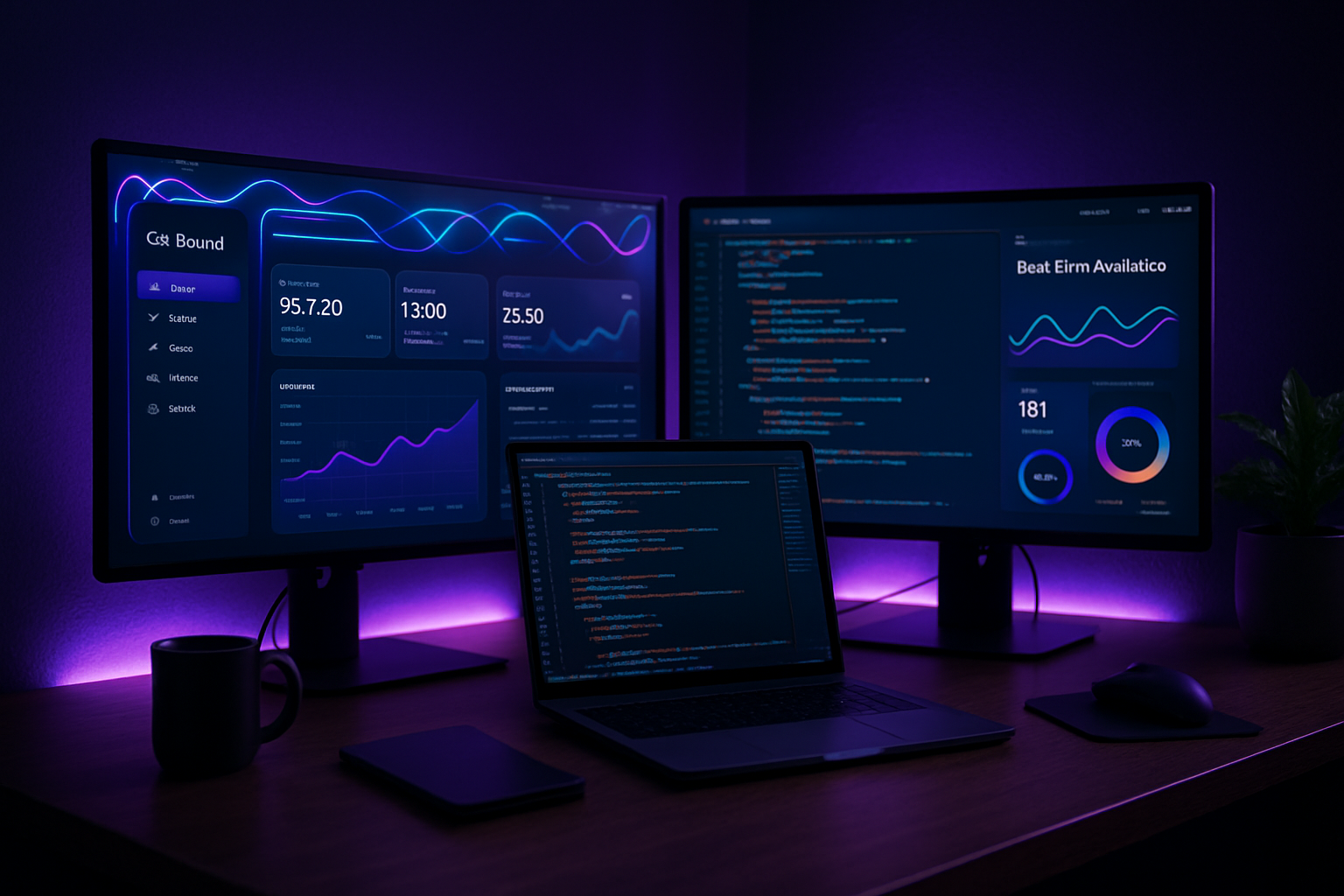Guide to Create a Dynamic Website in 2025
Web technologies are evolving at lightning speed, reshaping how we interact online. In 2025, businesses and creators must adapt to stay competitive, making it essential to create a dynamic website that keeps users engaged and returning.
This comprehensive guide is designed to help you create a dynamic website from the ground up. You’ll discover the latest tools, frameworks, and strategies that power today’s most interactive and scalable sites.
Dynamic websites offer real advantages—scalability, personalization, and the ability to stand out in a crowded digital landscape. Whether you’re building an eCommerce store, a SaaS dashboard, or a content platform, the right approach can set you apart.
Ready to future-proof your online presence? Follow this step-by-step guide to create a dynamic website that thrives in 2025 and beyond.
Understanding Dynamic Websites in 2025
Dynamic websites are at the heart of the modern web. Unlike static sites that serve the same content to every visitor, dynamic sites respond to user input, update content in real time, and connect seamlessly with databases. If you want to create a dynamic website, understanding these core differences is essential for success in 2025.

Defining Dynamic Websites and Their Core Features
What sets a dynamic website apart? At its core, a dynamic website delivers content that adapts to user actions or preferences. This means every visitor might see something unique, whether it’s a personalised news feed, a product recommendation, or tailored dashboards.
Key features include:
- Real-time content updates: News, inventory, or data refresh instantly as users interact.
- User interactivity: Features like comments, reviews, or live chat make the site feel alive.
- Database integration: Content is pulled from databases, enabling massive scalability.
For instance, when you create a dynamic website for an eCommerce store, you enable product searches, user accounts, and order tracking—all updating on the fly. Social media platforms and SaaS dashboards are other prime examples.
Dynamic content is vital for boosting engagement and SEO. Functions like user logins, personalised feeds, and integrated content management systems are now expected by users in 2025.
Key Trends Shaping Dynamic Websites in 2025
The landscape to create a dynamic website is rapidly evolving. AI-driven personalisation is taking center stage, offering recommendations and content tailored to each visitor. Voice search and conversational interfaces are making sites more accessible and interactive.
Progressive Web Apps (PWAs) are transforming websites into app-like experiences that work seamlessly across devices. The rise of headless CMS and API-first architectures allows for greater flexibility and faster development. Mobile-first and responsive design remain non-negotiable, ensuring every user has a smooth experience.
Want to dive deeper into how AI is reshaping dynamic web experiences? This AI-driven personalization in web development guide covers the latest strategies and tools shaping 2025.
Advantages and Challenges of Dynamic Websites
Why create a dynamic website instead of a static one? The benefits are clear:
- Scalability: Easily grow your user base and content without breaking a sweat.
- Real-time updates: Instantly reflect changes in inventory, news, or user activity.
- Enhanced user experience: Personalisation keeps visitors engaged and coming back.
However, dynamic sites come with challenges. Security is more complex, as data is constantly in motion. Performance optimisation is crucial—slow sites lose users. Development can be more involved compared to static alternatives.
A recent industry trend from 2024 shows that over 70% of users expect personalised experiences. Major brands leverage dynamic features to drive growth and outpace competitors.
When to Choose a Dynamic Website
It makes sense to create a dynamic website when your project demands flexibility and interactivity. Static sites, while fast and simple, can’t handle scenarios like:
- eCommerce stores: Need inventory management, user accounts, and payment processing.
- Membership portals: Require secure logins and personalised dashboards.
- Content-heavy platforms: Blogs, news, or SaaS tools with frequent updates.
For startups and SMEs, the choice depends on your goals and growth plans. If you anticipate scaling or want to offer a tailored user journey, dynamic is the way to go. Always weigh your business case and technical requirements before making the leap.
Planning Your Dynamic Website Project
Careful planning is the first step if you want to create a dynamic website that stands out in 2025’s crowded digital space. Laying a strong foundation ensures your site meets business goals, serves users effectively, and scales as you grow.

Defining Your Website Goals and Target Audience
Start by clarifying exactly why you want to create a dynamic website. Is your aim to attract new customers, deliver real-time data, or launch an engaging eCommerce platform? Define measurable business objectives and key performance indicators (KPIs) to keep your project on track.
Next, identify your primary users. Develop personas that capture their needs, behaviors, and pain points. Map out typical user journeys, from first visit to conversion. For example, a SaaS startup might focus on tech-savvy professionals seeking instant analytics and seamless onboarding.
When you create a dynamic website with clear goals and a deep understanding of your audience, you set the stage for lasting engagement.
Researching Competitors and Industry Standards
Before you build, study the competition. Analyse rival sites for features, user flows, and tech stacks. Tools like SimilarWeb, BuiltWith, and Google Trends can reveal which frameworks and functionalities are trending.
- List their core features and unique selling points.
- Note design elements and navigation strategies.
- Identify gaps your site can fill.
For example, platforms like Wix and GoDaddy offer some dynamic features but often limit deep customisation. Learning from their strengths and weaknesses helps you create a dynamic website tailored to your market’s needs.
Creating a Feature List and Site Structure
Now, brainstorm and prioritise the features your users expect. Think about:
- User accounts and roles
- Search and filtering tools
- Content management systems
- Real-time notifications or chat
Sketch your site’s structure using wire framing tools like Figma or Adobe XD. Plan logical navigation and a content hierarchy that scales. For inspiration and quicker prototyping, consider exploring professional website templates that can jumpstart your design process.
When you create a dynamic website with a well organised structure, you make it easier for users to find what they need and for your team to expand the site later.
Budgeting and Resource Allocation
Estimate your total project costs. Factor in development, hosting, third-party integrations, and ongoing maintenance. Consider these options:
| Resource Model | Pros | Cons |
|---|---|---|
| In-house | Full control, teamwork | Higher fixed costs |
| Freelancers | Flexible, specialised | Requires oversight |
| Agencies | Turnkey solutions | Higher upfront cost |
Cloud hosting providers like AWS offer scalable plans for less than $5/month if you’re starting small. Decide where to allocate funds for maximum impact as you create a dynamic website.
Timeline and Milestone Planning
A realistic timeline keeps your project moving. Break down the process into clear phases—design, development, testing, launch—and assign deadlines to each.
Leverage agile project management for flexibility. Use sprints and iterative releases to gather feedback early and often. Setting milestones helps you track progress, adapt to surprises, and ensure every part of your plan supports your goal to create a dynamic website that thrives in 2025’s fast-paced digital world.
Choosing the Right Technology Stack
Selecting the right technology stack is the foundation when you want to create a dynamic website that stands out in 2025. The choices you make here impact scalability, speed, and user experience. Let’s break down the options that empower modern web projects.

Frontend Technologies for 2025
The frontend is where users interact with your site, so choosing robust frameworks is essential when you create a dynamic website. In 2025, React, Vue.js, Angular, and Svelte continue to lead the way by enabling responsive, component-driven UIs. TypeScript is now a must-have for safer, scalable code, working hand-in-hand with modern JavaScript features.
Accessibility and performance are non-negotiable. Responsive layouts, ARIA roles, and semantic HTML ensure everyone can use your site. Progressive Web Apps (PWAs) remain a key trend, offering offline access and native-like speed. To stay ahead, explore the latest Progressive Web Apps trends 2025, which highlight mobile adoption and AI integration.
Backend Solutions and Languages
A solid backend powers the logic and data management when you create a dynamic website. Node.js is a go-to for real-time apps, while Python (Django/Flask), Ruby on Rails, PHP (Laravel), and Go provide flexibility for different project needs.
API-first development is now standard. Microservices architectures help break complex sites into manageable pieces, boosting scalability and reliability. For example, Node.js with Express makes it easy to build RESTful APIs and handle real-time updates. Always align your backend choice with project goals and your team’s expertise.
Databases and Data Management
Data is the lifeblood when you create a dynamic website. You’ll choose between SQL databases like PostgreSQL and MySQL—great for structured data and complex queries—or NoSQL options like MongoDB and Firebase, which excel with flexible, scalable data models.
Cloud database solutions are gaining traction for real-time synchronisation and global performance. Opt for a database that matches your scalability needs, supports high availability, and integrates seamlessly with your backend stack. The right database ensures your site can handle growth and deliver personalised experiences.
Hosting and Deployment Options
Where and how you host your site matters when you create a dynamic website for modern audiences. Shared hosting is cheap but limited. Virtual Private Servers (VPS) and cloud providers like AWS, Azure, and Google Cloud offer more power, flexibility, and scalability.
Serverless architectures and edge computing are rising trends, letting you deploy functions globally for ultra-fast response times. For most projects, VPS hosting balances cost and performance, with providers like Hostinger, IONOS, and AWS at the top. Prioritise uptime, security, and easy scaling as your site grows.
Integrating Third-Party Services and APIs
To create a dynamic website that meets user expectations, integration is key. Payment gateways, authentication services, analytics, and marketing tools add essential features without building from scratch.
Headless CMS options give you content management without tying you to a specific frontend. Look for APIs that are well-documented, secure, and easy to update. This modular approach accelerates development and future-proofs your project.
Evaluating No-Code and Low-Code Platforms
No-code and low-code tools like Wix, GoDaddy, and Squarespace make it possible to create a dynamic website without deep technical skills. They offer drag-and-drop simplicity, pre-built components, and fast deployment.
However, these platforms have limits in customisation and scalability. For startups or professional projects needing unique features or complex integrations, custom development is often the better route. Consider your goals, budget, and long-term needs before choosing a no-code solution.
Step-by-Step Guide to Building a Dynamic Website
Building a modern site in 2025 means more than just launching a few static pages. If you want to create a dynamic website that stands out, you need a clear roadmap. This step-by-step guide will walk you through every stage, from setting up your environment to going live with a high-performing, interactive platform.

Step 1: Setting Up Your Development Environment
The first step to create a dynamic website is establishing a solid development environment. Start by downloading a reliable code editor like VS Code or Sublime Text. Install Git for version control to track your progress and collaborate with others.
Set up Node.js and npm (or yarn) as your package manager. Initialise your project with
git init
and create a remote repository on GitHub or GitLab. This foundational setup ensures smooth workflows, easy collaboration, and secure backup for your codebase.
Don't forget to configure your
.gitignore
file to keep sensitive data out of your repo. Establishing these basics now saves you countless headaches down the line. With your environment ready, you’re already on your way to create a dynamic website that’s maintainable and scalable.
Step 2: Designing UI/UX for Engagement
To create a dynamic website that users love, focus on design early. Start with wireframes using Figma or Adobe XD. Map out user flows, navigation, and interactive elements that will elevate engagement.
Prioritise responsive layouts. Use a mobile-first approach to ensure your site looks great on any device. Leverage design systems and reusable components for consistency. Don't overlook accessibility—colour contrast, keyboard navigation, and alt text are essential.
Think about the user journey. Where do they click first? What draws their attention? Effective UI/UX design bridges the gap between user needs and business goals, setting the stage for a compelling site experience.
Step 3: Developing the Frontend
Now it’s time to bring your designs to life. Choose a modern framework like React, Vue.js, or Angular to create a dynamic website that’s fast and interactive. Set up your project structure, then start building out pages and components.
Implement dynamic rendering for real-time content updates. Use state management libraries (Redux, Vuex) to handle user data and interactions. Integrate APIs for seamless communication with your backend.
Focus on performance: lazy load images, split code, and optimise assets. Test your UI across browsers and devices to ensure consistency. A well-built frontend is the face of your dynamic website, so make it shine.
Step 4: Building the Backend and Database
Behind every great dynamic site is a robust backend. Select your server technology—Node.js with Express, Python with Django, or PHP with Laravel are solid choices. Set up RESTful APIs or GraphQL endpoints to handle data exchange.
Choose a database that fits your needs. SQL options like PostgreSQL offer structure, while NoSQL databases like MongoDB provide flexibility. Connect your backend to the database and implement authentication, user management, and core logic.
Security is key. Use environment variables for secrets and implement input validation. With a strong backend, you ensure your site can scale and handle complex functionality as you create a dynamic website.
Step 5: Integrating Essential Features
To truly create a dynamic website, you need features that drive engagement. Start with user registration, login, and profile management. Add a content management system (CMS) or build a custom admin dashboard for easy updates.
Consider real-time features like chat, notifications, or live feeds using WebSockets or third-party APIs. Integrate payment gateways if you’re building an eCommerce platform. These features add depth and keep users coming back.
Plan for scalability—design features so they’re modular and easy to extend. The right integrations transform your site from static to truly dynamic.
Step 6: Testing and Quality Assurance
Testing is non-negotiable if you want to create a dynamic website that performs flawlessly. Write unit tests for individual components, integration tests for workflows, and end-to-end tests for user journeys.
Automate testing with tools like Jest, Cypress, or Selenium. Don’t skip manual QA—test your site across browsers, devices, and screen sizes. Check for accessibility, broken links, and performance issues.
Use continuous integration pipelines to catch bugs early. Comprehensive testing ensures your dynamic site is reliable, secure, and user-friendly from day one.
Step 7: Deployment and Launch
With development complete, it’s time to launch. Optimise your assets—minify code, compress images, and set up caching. Configure your hosting solution, whether it’s AWS, Vercel, or traditional VPS.
Secure your domain and set up SSL for encrypted connections. Prepare a launch checklist: create backups, set up monitoring, and integrate analytics. Announce your launch and monitor performance closely in the first days.
Launching is a milestone, but it’s just the start. To create a dynamic website that thrives, plan for regular updates and ongoing optimisation.
Example Project Walkthrough
Let’s put it all together with a real-world example. Suppose you want to create a dynamic website for an eCommerce store. Start by setting up your environment and designing mobile-friendly product pages.
Build the frontend using React, integrating features like product search and user accounts. Develop a Node.js backend, connect to a MongoDB database, and implement secure payment processing. Test every feature, then deploy on a scalable cloud platform.
For a seamless head start, consider leveraging Dynamic eCommerce website solutions to access powerful tools tailored for interactive online stores. With these strategies, you’re ready to create a dynamic website that supports growth and delivers a standout shopping experience.
Optimising Your Dynamic Website for Performance and SEO
Building an engaging site is just the first step when you create a dynamic website. To stand out in 2025, you need to focus on performance and SEO from the ground up. A fast, optimized website not only attracts visitors but also keeps them coming back.
Enhancing Site Speed and Responsiveness
Speed is a non-negotiable factor when you create a dynamic website. Users expect instant loading and seamless navigation.
- Use code splitting and lazy loading to minimise initial load times.
- Optimise images by compressing files and serving modern formats like WebP.
- Implement content delivery networks (CDNs) to distribute assets globally.
A simple way to check performance is with tools like Google Lighthouse. Here’s a quick comparison of optimization strategies:
| Strategy | Impact | Tools |
|---|---|---|
| Lazy Loading | High | Native, JS libs |
| Image Compression | High | TinyPNG, Squoosh |
| CDN Integration | Very High | Cloudflare, AWS |
By prioritising these steps, you’ll ensure your dynamic website is both fast and responsive.
On-Page and Technical SEO Best Practices
Search visibility is crucial when you create a dynamic website. Start by structuring headings, meta tags, and schema markup for every page.
- Use descriptive, keyword-rich titles and URLs.
- Build XML sitemaps and submit them to search engines.
- Ensure your content hierarchy is logical and accessible.
For advanced tips, check out SEO optimization for websites to stay ahead in 2025. Technical SEO, like mobile optimization and semantic HTML, further boosts your search ranking.
Monitoring and Analytics
Once you create a dynamic website, continuous monitoring is key to maintaining performance and growth.
- Integrate Google Analytics for real-time data on user behavior.
- Use Google Search Console to track indexing and keyword performance.
- Set measurable KPIs, such as page speed scores and bounce rates.
Regular audits help you catch issues before they impact users. Reviewing analytics dashboards weekly enables you to make data-driven decisions for ongoing improvements.
Continuous Improvement and A/B Testing
Optimisation doesn’t stop after launch. When you create a dynamic website, gather user feedback and test new features regularly.
- Run A/B tests on headlines, layouts, or calls-to-action.
- Deploy updates iteratively to enhance user experience.
- Use heatmaps and session recordings to understand user journeys.
Iterative testing ensures your website evolves with user needs and industry standards, keeping you competitive in a rapidly changing digital landscape.
Security, Scalability, and Future-Proofing Your Website
Building trust and ensuring long-term success when you create a dynamic website in 2025 means prioritising robust security, seamless scalability, and readiness for future trends. Let’s break down how to safeguard, scale, and future-proof your site for ongoing growth and innovation.
Implementing Robust Security Measures
Security is foundational when you create a dynamic website. Start with SSL certificates to encrypt data and protect user privacy. Use secure authentication methods like OAuth or multi-factor authentication. Regularly update all software components and dependencies to reduce vulnerabilities.
Consider these essential practices:
- Use encrypted connections for all data transfers.
- Schedule automated backups and vulnerability scans.
- Employ firewalls and malware detection tools.
A secure website builds user trust and helps you comply with regulations such as GDPR and ADA. Regularly review access controls, and educate your team about potential threats. By prioritizing security from day one, you create a dynamic website that stands resilient against evolving cyber risks.
Ensuring Scalability and High Availability
As your audience grows, it’s vital to architect for scalability. Use cloud infrastructure with auto-scaling and load balancing to handle traffic spikes efficiently. Optimise your database with indexing and caching for faster access.
Key strategies include:
- Deploy on cloud platforms like AWS or Azure for flexible scaling.
- Implement load balancers to distribute traffic.
- Use Content Delivery Networks (CDNs) for global reach.
Performance is also being transformed by emerging technologies. For example, WebAssembly's impact on web apps enables near-native execution speeds, helping you create a dynamic website that handles complex features without lag. Always test your site under load to ensure high availability and a seamless experience.
Preparing for Future Web Trends
To future-proof your site, keep pace with the latest web innovations. Integrate AI for personalization and automation. Explore AR/VR, IoT, and voice search to enhance user engagement. Design with mobile-first principles to ensure universal accessibility.
Emerging network technologies are reshaping the web. The 5G's influence on web development is unlocking real-time features like AR and high-quality streaming, which can power the next generation as you create a dynamic website. Stay updated with best practices and compliance guidelines to remain competitive.
Maintenance and Ongoing Support
Ongoing maintenance is essential to keep your site secure and running smoothly. Schedule frequent content updates, bug fixes, and feature enhancements. Document all processes, and set up user support channels for quick assistance.
Best practices for maintenance:
- Automate backups and software updates.
- Monitor site performance and uptime with analytics tools.
- Plan for future migrations and technology upgrades.
When you create a dynamic website, proactive support ensures stability and user satisfaction. Regular reviews and updates help your site adapt to changes in technology and audience needs.
Ready to put your new knowledge into action? With everything you’ve learned about planning, building, and optimizing a dynamic website for 2025, there’s never been a better time to get started. You don’t need coding skills or a big team—Avantiy’s AI-powered platform gives you all the tools, templates, and support to launch a professional, high-performing website that grows with your goals. Whether you’re dreaming of an online store, blog, or portfolio, you can bring your vision to life quickly and easily. Let’s take the next step together—Start Building Your Website Today.
Start building your new website today
No credit of debit card required start building today




